An Abandoned Mansion from Lebanon’s Past
 Show on map
Show on map
By Craig Finlay
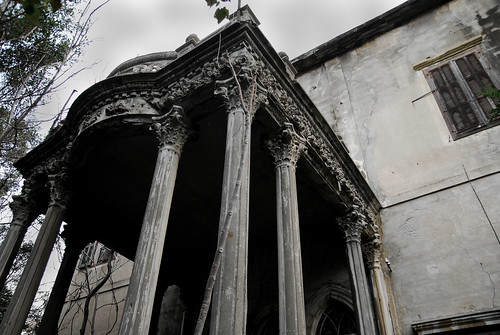
Downtown Beirut is full of silent and boarded buildings, which stand between the featureless identical cement apartment blocks that make up the periphery. Most are pockmarked with bullet holes and — in places — red, Mediterranean-style ceramic tiles have fallen away, revealing the woodwork beneath. Still, these damaged, pre-civil war houses, mansions and apartment buildings manage to recall more than a little of the elegance that earned Beirut the title, “Paris of the Middle-East.” It’s a blatantly colonial term, given to the city by the French during their “administration” of the country from the end of the first world war until the end of the second. But the dirtied white facades of these buildings manage to catch the low-slanting light of sunset with a defiant brilliance their sterile replacements just can’t muster. They were designed to catch Mediterranean sunsets.
On Rue Spears, a couple of blocks past the Saneyeh park towards downtown, a prime example of Lebanese pre-war architecture sits mouldering behind a forbidding stone wall. I saw it on my first day of a 2008 winter break trip to Beirut to visit my father, a professor at the Lebanese American University. There is a certain prestige implicit with being the first explorer to hit an important building, and as far as I could tell there were no active explorers in all of Beirut. As such, I was out on the street every day at sunrise, hoping to make the best of my two weeks there.
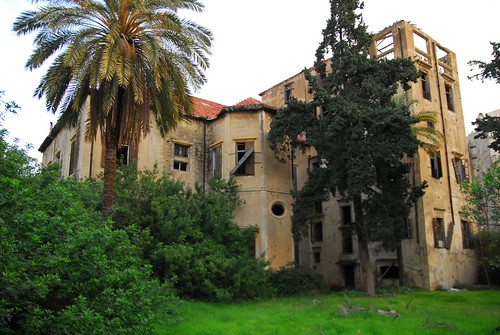
This building is a standing, contradictory dichotomy — dark and gorgeous at the same time. The 10-foot high wall and chained, rusting gates create an atmosphere of something off-limits yet irresistible; its very demeanor from the outside implicitly suggests a world of secrets to discover.
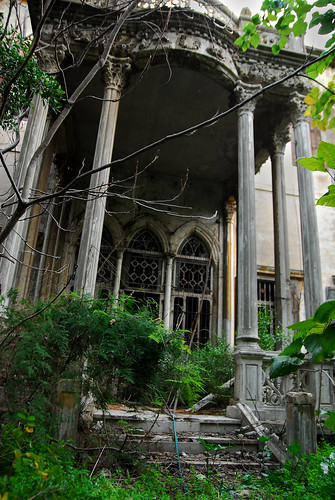
On my first trip out I circled the block alone to find myself receiving suspicious stares from the urban-camouflaged Lebanese police. These eagle-eyed sentries stand near red and white striped guard houses glowering with their M-16s. Societally, cameras are looked upon with suspicion in Beirut. Tourists fare better than most, but any photographer walking around taking snapshots can expect to be questioned by a security or policeman.
This was especially so around the LAU campus, where I studied in 2003. The LAU campus sits adjacent to Saad Hariri’s palace, a gigantic structure built in the old pre-war Mediterranean style. Every time I walked in or out of the front gate with a giant Nikon hanging from my neck a security guard would run up to me repeating “No photo, no photo,” like a magic, protective mantra. I wonder if it ever occurred to them that a spy would probably use a smaller, less obtrusive camera than a D200. I mean, a DSLR doesn’t exactly fit into a belt buckle or a pack of cigarettes. I wonder how they would react if they knew the entire layout of the grounds is readily available on Google Earth. Still, they have good cause to be nervous.
In 2005 Saad’s father, former prime minister and billionaire Rafic Hariri was killed, along with 21 other people, by a massive car bomb in front of the St. George Hotel in Beirut. A Lebanese man I met told me that the hotel’s owner was one of Hariri’s opponents, and Saad has since blocked any attempts to rebuild the place. It sits vacant on the sea, another monument to violence. Since then, Saad has assumed leadership of the Sunni and Maronite anti-Syrian coalition — Hezbollah’s chief competition. These simmering tensions, amplified by the subsequent withdrawal of Syrian troops from the country and the 2006 war between Hezbollah and Israel, exploded in a mini-civil war in 2007, during which Hezbollah fighters occupied and burned FutureTV, owned by Saad, the mouthpiece of the anti-Hezbollah Future Movement.
I recall speaking to my father on the phone then, me in rural Illinois working my first newspaper job, he in his campus apartment — the roar of gunfire from the street below competed with his voice for my attention. I recall not only the expected, intense worry for his safety, but how disconcerted I was by his own apparent lack of it. He was more upset by the fact that the cable was out than by the rocket propelled grenades aimed at Hariri’s Palace, a couple of hundred feet away.
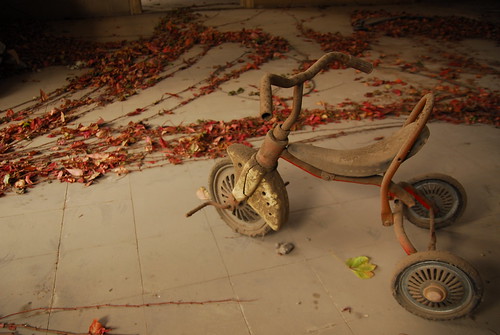
My father’s relative indifference could have stemmed from a regional adjustment to conflict. The waves of violence in Beirut hit like the seasonal flooding of an undammed river. The waters pull back, the silt settles and the shop keepers on Hamra sweep the dust off their doorways, no longer surprised by much of anything.
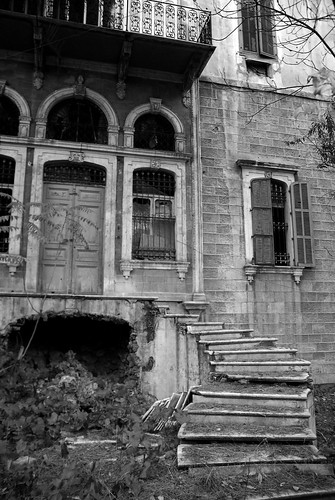
The decaying mansion I set out to explore sits across the street from the new FutureTV office, and the guards, manning a checkpoint a block way, stare in that way that always strikes the few American tourists who come to Beirut. It’s simply not considered rude to lock eyes with strangers for extended periods of time. And when the person staring at you is holding a loaded machine gun it sets your nerves on edge. So, after two trips around the block trying to find a way in, I decided to head home rather than have to again explain to a policeman why I had a camera; what I was taking pictures of; why I wanted to take pictures, etc. At first, the only glimpse I got was through a hole in the back gate. I saw an overgrown courtyard, full of trees and bushes that obscured the quiet and vacant mansion.
It wasn’t until a few days later that I went back, this time with Michel, a friend who works in computers downtown. It was his first time exploring; I don’t speak Arabic and figured a translator would be handy if I encountered anyone in the building.
We walked around to the front courtyard and bought local energy drinks from the corner shop that occupies the lower part of what was once the mansion’s guard house. Down the street is a small car repair shop, and we ducked behind it, seeking a secluded place to scale the wall. Walking down the alley between the courtyard wall and what appeared to be another abandoned building to the right, I was reminded of why exploring abandoned buildings in Beirut is a tricky business – you have to be considerate of the people who live in them.
The truth is, despite being home to a great many abandoned buildings, Beirut has very few vacant ones. Look beyond the pristine beauty of the rebuilt downtown area or the ritzy, exclusive dance clubs around Monot street — packed with rich kids going to school at LAU or AUB — and you’ll find a grossly unequal distribution of wealth in Lebanon.
About a kilometer from the giant and gorgeous blue-domed mosque built by Rafic, Syrian day laborers loiter around a filthy, vacant lot hoping for a day’s work. Many of these people choose to live rent-free in the many abandoned buildings of the city, often stealing power and even photo service from nearby lines. Look up in some places around the city and the huge number of pirated electric and phone lines forms a kind of multi-colored spiderweb, intricate and impressive.
This abandoned building, adjacent to the mansion we sought to explore, had a similar life support system jacked in from the city’s power grid. Laundry hung out on balconies and potted plants added a bit of color. Baskets hung on ropes that reached from top floor balconies to the alley below. It’s a general rule — if a building can provide shelter for someone, chances are it does.
We scaled the wall, one at a time; Michel provided me with a boost and I pulled him up in turn. The courtyard of the mansion must have been gorgeous. Giant, old trees of that strange type in Lebanon that throws down roots from the limbs into the ground, creating a miniature forest, dotted the landscape. Garbage was everywhere — old luggage, tires, children’s toys and literally thousands of empty plastic bottles. A dead white rabbit lay in a tree, balanced on a piece of carpet. I have no idea who put it there or why; it might have been one of the army of stray cats that live short, desperate lives in orbit around the city’s dumpsters. I quickly took its picture.
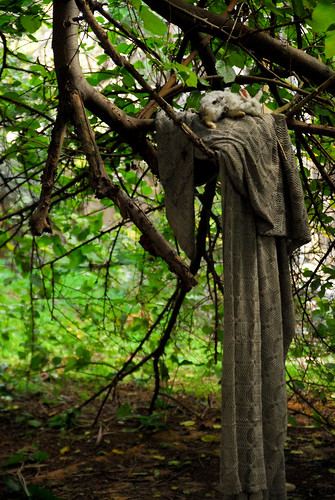
I wasn’t surprised when we saw a power line leading into the side of the building, as well as a garden hose. The doors on this side entrance were nailed shut from the inside, and the hose and power lines were threaded through holes drilled in the wood. Someone was living there, that was certain. I expected Michel to want to turn back, but he’d received an adrenaline jolt from hopping the wall and wanted to find a window to climb through. Fair enough, I said, conscious that I just agreed to go inside of someone’s home. Walking around to the front, I looked back at the side entrance and was really struck by how wealthy the former tenants must have been. Even though it was only the side door, it was flanked by tall, elegantly carved columns. It was an entrance worthy of any mansion, yet before the war it was probably used by house workers to bring in food and take out garbage.
We moved around to the front. Identical sets of white marble steps flanked an empty fountain and buttressed the arched and ornate French doors. It was then, as I turned facing the cobbled entrance road, that I imagined black European luxury cars stopping to disgorge impossibly well-coiffured party guests. We jimmied the door using a long piece of cut marble fallen off the steps to push aside the board that someone had jammed into the door. Michel had a big grin on his face, finding out what more experienced explorers already know and what keeps us coming back: the need to see the forbidden and off-limits is ingrained in our DNA as humans.
The barricade fell with a clatter and we entered the grand hall, silent and accepting. There were no footprints in the deep dust that covered the floor; we walked in a silent, reverent fashion that the building seemed to demand of us. Our footsteps were light and silent; our voices half-whispers.
What immediately caught my eye was the giant pile of papers at the end of the hall. Upon closer inspection many of the papers turned out to be black and white photographs — hundreds of them, all of the same elderly man in a tall, flat-topped Fez-style hat, at what appeared to be political events. In some of the photos the walls were covered in campaign posters bearing his image. Always: Around him were supporters, cheering and clapping. The other documents, Michel told me, were voter registration lists – hundreds of names, addresses and phone numbers. There were also various memos and letters. He didn’t know who the man in the photo was.
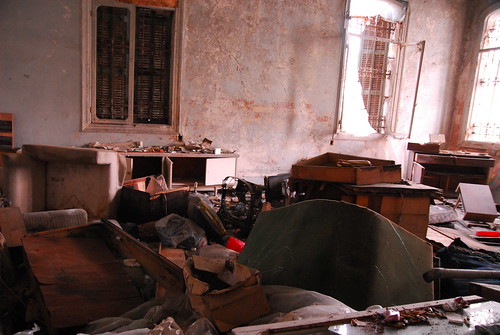
Michel went upstairs and I took out my tripod to shoot the photos in the low light. My camera’s timer, a soft beep, beep, beep seemed to echo in the dead, cold hall. It was after the third or fourth shot that I heard the footsteps behind me, crunching the broken glass of a long-shattered window. I turned, expecting to see Michel. Instead I encountered the scowl of a very large and very humorless Syrian man in heavy boots. His shoulders were gigantic, the product of years of manual labor. His eyes had no smile lines.
“I…I’m just taking pictures,” I offered, impotently, not expecting him to understand.
“It’s not open,” He replied, in what my memory holds to have been a deep growl.
“I…noticed.” And we just kind of stared at each other.
I was saved by Michel, who came down to tell me of a desk he found upstairs. A short exchange ensued which Michel later translated to me as:
Syrian: “You’re not allowed to come in here.”
Michel: “Well, we already are.”
Michel’s kind of gutsy like that. Especially considering the man could have easily kicked our teeth in. As it was, he agreed to give us 20 minutes after realizing we weren’t cops. We moved upstairs quickly, deciding to forsake the south wing of the house where we assumed the squatters lived. The clatter of our break-in must have echoed throughout the house.
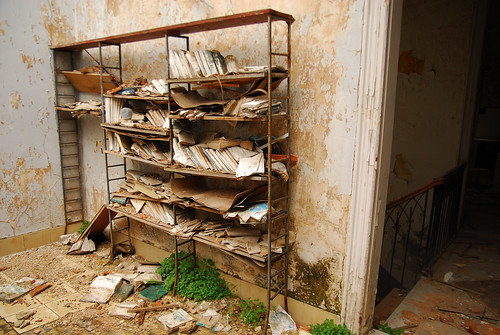
Upstairs we found more clues as to the political nature of the home. A bookshelf, full of rotting books, sat in a room no longer protected by a roof. They were all political texts, some in French, some in Arabic. A book by Francois Mitterrand; another entitled, “for Lebanon” — books ruined by years of rainy Beirut winters.
In the next room was large wooden desk, of the sort befitting a president or CEO, Michel remarked. It sat next to pointed, arched windows and a balcony with a view of the courtyard and street below. I looked out and saw two bored Lebanese policeman smoking cigarettes and watching the passing cars. One of my favorite parts of exploring is looking out of windows on upper floors and watching cars, cyclists and joggers who pass and don’t look up where I am — a place I can’t help but notice.
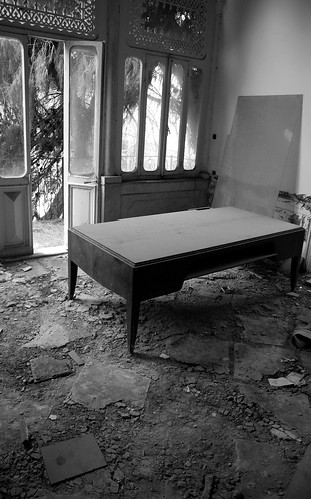
There were Bedrooms, too. They were covered in an inch of red sand and colorful, flowered wallpaper. A few televisions, newspapers, some empty cigarette packets. The kitchen had been used by squatters at one point — an unopened can of peaches sported a 1988 expiration date. And they had left behind half-full barrels of cooking oil and a large bag of rice. Photos of female Lebanese pop stars torn from magazines decorated some of the walls.

There were bullet holes in the wall opposite the windows. Someone who had spent his or her mornings making spare breakfasts likely sought an antidote against those bullet holes; they saw in the perfect teeth of a pop star, the rim light and soft-focus photography, something better than the monotonous clattering of gunfire that drifted in like a cold front from the Green Line.
We only explored part of the mansion, content that something was better than nothing. With our presence known and no doubt communicated to whoever else was living there, we decided that overstaying our already cold welcome would be foolhardy, especially if they found out how we’d entered.

“He asked us how we managed to get in,” Michel laughed. “I told him we climbed in through an open window”
“What if he looks at the door and finds we kicked it in?”
“I dont’ think he’d be happy.”
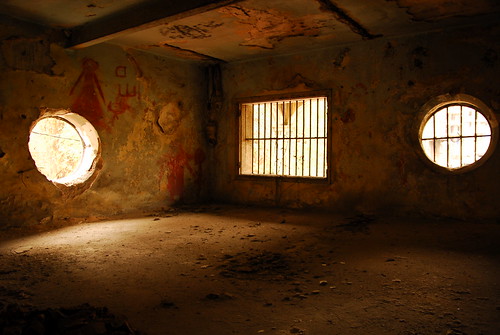
On our way out we grabbed as many of the photos as we could. It seemed wrong to let them slowly decay, falling prey to piss and rainwater. As we re-crossed the courtyard I looked back and saw three windows on the third floor of the south wing filled with men staring at us, these strange intruders. I waved. They did not wave back.
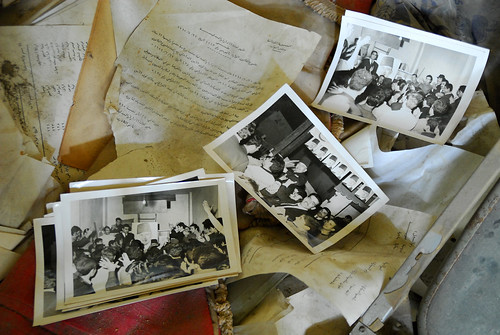
A few days later I dropped in on Bassam Lahoud, photography professor at the Lebanese American University. A man for all seasons, Bassam is an architect, writer and dance instructor. He’s from Amchit, a small, charming mountain village near Byblos, the longest continually inhabited city on the planet. Bassam taught me how to use a camera, a Canon 35mm A1 from the 1970s. He runs a foundation with the modest aim of collecting every single photo ever taken of Lebanon. Any photo. Of anything. I handed him the warped stack of black and white photos from the mansion.
“Takkieddin el-Solh” he said. “He was a prime minister.”
We had broken into the former prime minister’s home. Evidently he had abandoned it when Beirut began to tear itself to shreds in 1975. His time in office had ended a year before. In 1980 he was asked by the president to form a government but was unable to find consensus in a country at war with itself. He died in 1988 in Paris.
“Can I keep one of these? For my foundation?” Bassam asked.
Of course. Of course. I gave him all of the photos, and copied 8 gigs of .jpg files onto his desktop. I wanted to feel like I was contributing something.
He looked at my photos of the mansion, the ones you’re looking at now. “Perhaps we could do an exhibition some time, at my house in Amchit, where we took the field trip.” He had taken his entire class to his home for a day to practice architectural photography. His house is gorgeous, a mansion too, built before the civil war yet free of scars. Yes, of course you can do an exhibition, Bassam. When I put them up on Flickr I set the license to Creative Commons.
I said my goodbyes to Bassam and went downstairs. Outside, there was a campus demonstration against the Israeli air assault in Gaza. Students chanted and burned Israeli flags. In a brief moment of unity, yellow Hezbollah flags waved next to the red and white Lebanese. “The enemy of my enemy is my friend,” and for the moment they had found in war a reason to come together. It’s not sustainable, I thought. I raised my camera and took their picture. Smoke billowed from burning flags, and painted faces cheered, chanted.
Further Reference

 Reddit!
Reddit! Del.icio.us
Del.icio.us Digg
Digg StumbleUpon
StumbleUpon Technorati
Technorati Blinklist
Blinklist Furl
Furl
Pingback: Damascus in Beirut « A Diamond’s Eye View of the World
Fascinating story, Jonathan. Now, I’ve used up my entire lunch break and I have to get back to work 🙂
The former prime minister’s home? This one was even more exciting to read than your visit to Neverland…
Andy Frazer
This is stellar.
Thanks Andy & Blaize. The moment I saw the photos, I knew Craig’s article would be a great addition to the site. It’s amazing – just when you think an epic abandonment leaves you (Neverland) another arrives (Takkieddin el-Solh’s mansion). Thank Craig for the excellent article.
Wow. This was simply wonderful. My husband is from Lebanon and we try to go back often. I love the old buildings and would love to be able to get a place like this there and restore it back to its beauty.
Thanks for sharing the pics and this wonderful storey.
This is a great story to accompany amazing photos. Thanks for sharing!
Pingback: Abandolandia « El baúl de Josete
Hi Craig,
I stumbled upon your article as I was researching Beirut for my upcoming trip. I left Beirut in 1984 and have been back only twice. This tird visit,after an absence of 15 yrs. I loved, loved your article and photos. I’ll make sure I visit that area downtown and see what I can catch a glimpse of – without scaling any walls and raising any suspicion. LOL
You took me about 30 years back with your little adventure. I remembered how when I was a child at the start of the war; we had gone up to the mountains and lived in a hotel for a while. Right next to the hotel there was a beautiful old abandoned mansion. It was in a better shape that this one, and the doors were open. We often would go into the main hall and play there. I took a few exploratory walks through the house on my own as well. But I unfortunately don’t remember a lot of what I saw. And I certainly didn’t take any pictures. We would often get yelled at by some adult to get out of the house for fear of something collapsing.
Please write more articles about other abandoned homes.
Thank you
Mayssa
Pingback: Abandoned mansions | Yourtravelpass
Pingback: Gothic Grandeur: Spooky Halloween « lifestyle Blog
Hello,
Wow!! I always walk past the walls of the mansion, and I always wonder of what it is like.
Would it be possible to send me more photos of the mansion? The photos you published in this article didn’t satisfy my curiosity! 😉
Thank you for sharing this story!!
Nada
do you have newsletters
Hello,
I’m an architecture student so i was making a research about old about houses in Lebanon and i ran through your article.
I really liked the way you were describing the place and that your curiosity led you to take this adventure.
This place is amazing.
Can I have some other pictures of the mansion please? I’m interested to know more about this place.